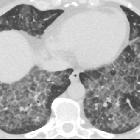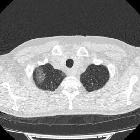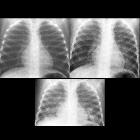crazy paving

The
crazy-paving pattern: a radiological-pathological correlation. Lymphangitic carcinomatosis. a Chest radiograph showed a pleural effusion in the right haemothorax. An increased linear pattern was seen in the left and right upper lung. b CT showed a diffuse crazy-paving pattern with areas of ground-glass attenuation and thickening of the interlobular septa (1). There were also some small nodular lesions visible mostly in the left upper lobe suggestive of pulmonary metastases (2). c Radiological-histopathological correlation. Histological examination of the autopsy specimen demonstrated thickening of the interlobular septa (*) due to fibrosis and the presence of tumour cells. There was also perivascular (arrow) thickening due to an expansion of lymphatic spaces by tumour cells. The histological reaction was that of diffuse alveolar damage and consisted of hyaline membranes in the alveolar ducts and respiratory bronchioles while the alveolar spaces fill with an exudate of proteinaceous material. This corresponded to the ground-glass opacities on CT. The reticular pattern was due to congestion of capillaries and oedema of the interstitium

The
crazy-paving pattern: a radiological-pathological correlation. Acute respiratory distress syndrome. CT revealed bilateral areas with ground-glass attenuation superimposed with a reticular pattern. These lines corresponded to thickening of the interlobular septa, but also thickening of the intralobular interstitium

Pulmonary
alveolar proteinosis • Pulmonary alveolar proteinosis - Ganzer Fall bei Radiopaedia

Pulmonary
alveolar proteinosis • Pulmonary alveolar proteinosis - Ganzer Fall bei Radiopaedia

Crazy paving
• Diffuse pulmonary hemorrhage - Ganzer Fall bei Radiopaedia

Pulmonary
alveolar proteinosis • Pulmonary alveolar proteinosis - Ganzer Fall bei Radiopaedia

Crazy paving
• Pneumocystis carinii pneumonia - Ganzer Fall bei Radiopaedia

Crazy paving
• Not so crazy street paving (photo) - Ganzer Fall bei Radiopaedia

The
crazy-paving pattern: a radiological-pathological correlation. a Anatomy of the secondary pulmonary lobule. b–e The reticular pattern: b thickening of the interlobular septa; c thickening of the intralobular interstitium; d irregular areas of fibrosis; e periacinar pattern

The
crazy-paving pattern: a radiological-pathological correlation. Usual interstitial pneumonia. a Chest radiograph showed patchy distribution of areas with consolidation and a fine reticular pattern, most pronounced in the periphery of both lungs. b A crazy-paving pattern was visible with scattered distribution. Superimposed on the ground-glass opacities a linear pattern with multiple small irregular lines was visible (intralobular fibrosis) (1). Traction bronchiectasis was seen in the periphery of both lungs (white arrow). c Radiological-histopathological correlation. On histology, thickening of the interstitium (arrow) with variable severity was seen, leaving some alveolar septa almost completely normal, whereas others were thickened. Fibrinous exudates, honeycombing (*) and mild inflammatory alveolitis were also present

The
crazy-paving pattern: a radiological-pathological correlation. Non-specific interstitial pneumonia. a Chest radiograph showed reticulation in the lung parenchyma, diffusely spread in both lungs, centrally and peripherally. b Chest CT showed a crazy-paving pattern especially at the periphery of both lungs. There was an increase in lung attenuation (ground-glass opacification) with a superimposition of a reticular pattern with thickening of the inter- (1) and intralobular (2) septa. c Radiological-histopathological correlation. Histological evaluation showed a homogeneous fibrotic thickening of the interstitium with inflammation. Macrophages were visible within the alveolar septa. Homogeneous interstitial inflammation was seen, corresponding to the diffuse ground-glass opacities, whereas fibrosis in the interstitium and alveolar septa (black arrow) was related to the superimposed linear pattern

The
crazy-paving pattern: a radiological-pathological correlation. Radiation pneumonitis. a Chest radiograph showed an area of consolidation in the right lung with an air bronchogram. There was also loss of volume of the right lung. b CT showed the therapy response of the tumour. There was patchy distribution of a crazy-paving pattern with increased lung attenuation (ground-glass opacity) and thickening of the interlobular septa in the right lung (1). c Radiological-histopathological correlation. Histological examination after autopsy showed airspace filling with an exudate in combination with thickening of the interlobular septa (arrow), thickening of the interstitium surrounding the airspaces and also the presence of irregular fibrosis (dotted arrow). Alveolar spaces filled with an exudate of proteinaceous material were responsible for the ground-glass opacities on CT. The reticular pattern was due to congestion of capillaries and oedema of the interstitium

The
crazy-paving pattern: a radiological-pathological correlation. Exogenous lipid pneumonia. a Chest radiograph showed a decrease in lung translucency in the caudal region of the right lung with an air bronchogram. b Chest CT showed a crazy-paving pattern with areas of increased lung attenuation and with thickening of interlobular septa (1), even thickening of the intralobular interstitium (2). c Radiological-histopathological correlation. Histological examination showed alveoli filled with lipid particles (*), some ingested in macrophages (+) with the formation of lipid granulomas

The
crazy-paving pattern: a radiological-pathological correlation. Pneumocystis jirovecii infection. CT showed a patchy distribution of areas with ground-glass opacification in both lungs, more pronounced in central parts, with a superimposition of a linear pattern

The
crazy-paving pattern: a radiological-pathological correlation. Pulmonary oedema. CT showed patchy distribution of areas with ground-glass opacification and a linear pattern. Most of the lines were thickened interlobular septa. Within the secondary pulmonary lobule, enlarged vascular structures with a spider configuration were seen. There were also some other intralobular lines

The
crazy-paving pattern: a radiological-pathological correlation. Alveolar proteinosis. a Chest radiograph showed a reticular pattern that was most pronounced in the central parts of the lungs. There was also a decrease in the lung translucency centrally in both lungs. Heart and central vessels were normal. There was no pleural effusion. b On CT, a patchy distribution of a crazy-paving pattern was visible. The lines corresponded to a deposition of material within the airspaces at the borders of the acini (1) in the secondary pulmonary lobules, but also along the interlobular (2) and intralobular septa (3): the periacinar pattern. c Radiological-histopathological correlation. Histopathological evaluation of a specimen out of the right lung showed amorphous eosinophilic material in the alveoli (*) positive on periodic acid Schiff (PAS) staining. This material corresponded to deficient surfactant. Filling of the alveoli (*) was responsible for the ground-glass appearance on CT. When the airspaces adjacent to the inter- and intralobular septa (black arrow) and to the alveolar walls filled, the periacinar pattern became visible

The
crazy-paving pattern: a radiological-pathological correlation. Sarcoidosis. CT showed a diffuse increase in lung attenuation (ground-glass attenuation) with the superimposition of an irregular reticular pattern: thickening of the interstitium and thickening of the peribronchovascular interstitium

The
crazy-paving pattern: a radiological-pathological correlation. Hypersensitivity pneumonitis. a Chest radiograph showed patchy distribution of areas with increased lung density. There was also an increase in the linear pattern in both lungs. b On CT, a crazy-paving pattern was seen with a geographic distribution of ground-glass opacities with the superimposition of thickened inter- (1) and intralobular (2) septa. The findings were seen predominantly in the upper lung areas. c Radiological-histopathological correlation. Histology demonstrated interstitial pneumonia with lymphocytes, plasma cells and foamy macrophages in the interstitium. Epithelioid granulomas without caseation were also seen. There was no fibrosis. The alterations in the walls of the alveoli and the inflammation in the interstitium were visible as thickening of the inter- and intralobular lines

The
crazy-paving pattern: a radiological-pathological correlation. Graft-versus-host disease. CT revealed multiple areas of ground-glass attenuation and consolidations. There was also a superimposition of multiple lines: thickened inter- and intralobular septa and intralobular fibrosis

The
crazy-paving pattern: a radiological-pathological correlation. Bronchioloalveolar carcinoma. CT showed patchy distribution of areas with ground-glass opacification and areas with consolidation. Superimposed on these areas there is a reticular pattern corresponding to the thickening of the interstitium

Long term
bronchoneumoniae that turned out to be a pulmonary alveolar proteinosis. Chest CT (axial (a,b,c and d) and coronal sections (d)) shows widespread geographic ground glass opacities accompanied by smooth thickening of the interlobular septal lines, the "crazy paving" pattern.

Long term
bronchoneumoniae that turned out to be a pulmonary alveolar proteinosis. Chest CT (axial (a,b,c and d) and coronal sections (d)) shows widespread geographic ground glass opacities accompanied by smooth thickening of the interlobular septal lines, the "crazy paving" pattern.

Chronic
eosinophilic pneumonia with crazy paving pattern. Axial chest CT image shows peripheral areas of crazy paving of the right pulmonary apex.

Chronic
eosinophilic pneumonia with crazy paving pattern. Axial chest CT image shows peripheral areas of crazy paving of the right pulmonary upper lobe.

Chronic
eosinophilic pneumonia with crazy paving pattern. Axial chest CT image shows peripheral scattering areas of crazy paving of the right pulmonary upper lobe.

Chronic
eosinophilic pneumonia with crazy paving pattern. Axial chest CT image shows subpleural scattering focal areas of crazy paving of the right pulmonary upper lobe.

Chronic
eosinophilic pneumonia with crazy paving pattern. Coronal chest CT image shows the scattered subpleural areas of crazy paving of the right upper lobe.

The
crazy-paving pattern: a radiological-pathological correlation. Organising pneumonia. CT showed patchy distribution of areas of ground-glass opacification with the superimposition of thickened interlobular septa

Crazy paving
• COVID-19 pneumonia - Ganzer Fall bei Radiopaedia
Crazy paving refers to the appearance of ground-glass opacity with superimposed interlobular septal thickening and intralobular septal thickening, seen on chest HRCT. It is a non-specific finding that can be seen in a number of conditions.
Pathology
Etiology
Common causes:
- acute respiratory distress syndrome (ARDS)
- bacterial pneumonia
- acute interstitial pneumonia: ARDS of unknown etiology
- pulmonary alveolar proteinosis (PAP): rare, but the great majority of patients with PAP demonstrate crazy paving
Less common causes:
- drug-induced pneumonitis
- radiation pneumonitis
- pulmonary hemorrhage / diffuse pulmonary hemorrhage
- chronic eosinophilic pneumonia
- usual interstitial pneumonia (UIP) with superimposed diffuse alveolar damage
- pulmonary edema
- pulmonary infections
- mycoplasma pneumonia
- obstructive pneumonia
- tuberculosis
- Pneumocystis jirovecii pneumonia (PCP)
- COVID-19
- cryptogenic organizing pneumonia (COP, formerly BOOP)
- invasive mucinous adenocarcinoma of the lung (formerly mucinous bronchoalveolar carcinoma
- sarcoidosis, especially alveolar sarcoidosis
- lipoid pneumonia
- pulmonary veno-occlusive disease
Siehe auch:
- Tuberkulose
- Lungenödem
- Sarkoidose
- Kryptogene organisierende Pneumonie (COP)
- acute respiratory distress syndrome (ARDS)
- Alveolarproteinose
- chronic eosinophilic pneumonia
- Pneumocystis jiroveci Pneumonie
- gewöhnliche interstitielle Pneumonie (UIP)
- pulmonale venookklusive Erkrankung
- pulmonary infection
- Strahlenpneumonitis
- Lipidpneumonie
- Akute interstitielle Pneumonie
- Pneumocystis carinii
- diffuse Lungenblutung
und weiter:

 Assoziationen und Differentialdiagnosen zu crazy paving-Muster:
Assoziationen und Differentialdiagnosen zu crazy paving-Muster:gewöhnliche
interstitielle Pneumonie (UIP)












